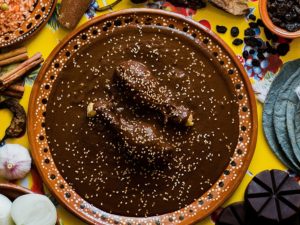Eduardo Rios isn’t sure what he’ll be roasting for Christmas dinner. It might be a turkey. Or if he can find one, maybe a big fillet of cod. What he does know is that it will be settled into a mole — the smoky, sweet, spicy, special-occasion sauce of his home country.
Rios is the chef at Spindler’s in Provincetown, where his “sabores de México” menu is a Wednesday night ritual that attracts those who feel acutely the distance between this place and a real tamale or tortilla. But even on other nights, if you are feeling especially deprived of warmth, and if Rios happens to have some on hand, you might be lucky enough to get a ladleful of mole alongside your grilled octopus.
Rios’s mother ran a breakfast and lunch stand at the Mercado de San Juan de Dios in Guadalajara, where he grew up. “There were eight of us,” he says, “but I was the one who at seven years old wanted to get up at five o’clock in the morning to help my mother make menudo, tamales, and enchiladas.”
The family had moved west from Mexico City to Guadalajara when he was young because his mother was from there and she wanted to be closer to her parents. Cuisines range widely across the huge and varied landscapes of Mexico, he says. But the main thing is that his city is a place “where people still enjoy sitting down to eat.”

In the capital’s distrito federal, he says, people are too busy to sit down anymore. “They’re on the move,” he says, “walking down the street eating their little bags of chapulines — crickets, you know.” Toasted grasshoppers, actually, seasoned with garlic, lime juice, chiles, and salt, say a crowd of American food authorities who seem anxious to prove their culinary adventurousness.
The slow pace of a mole suits Rios just fine.
“In Mexico, you might make it two or three times a year — for Christmas or for New Year’s Eve, or for an important birthday,” Rios says. But he starts a batch every Tuesday for the Wednesday night menu at Spindler’s.
There are hundreds of versions of mole, but most involve toasting spices and nuts, charring vegetables, and long, slow simmering. A good mole surprises bite by bite, revealing layers of flavors from cloves and cinnamon to pumpkin and sesame seeds, raisins, and a good grating of dark chocolate.
“The secret,” says Rios, “the thing that makes a truly good mole, is the caldo — the stock.”
At 20, Rios came to the U.S., landing in Santa Fe, N.M. At least it was a chile-loving place.
“I was passionate about food,” he says. “But I got a job washing dishes.” He liked being in restaurants and made a point of hanging around the kitchen, offering to help, until, exasperated, one boss let him start cooking.
Cooking has taken him to Los Angeles and to Boston. And, about four years ago, he heard about a job on the Cape. He knew something about Cape Cod. “I grew up listening to stories about this extraordinary man, John F. Kennedy,” he says. “I had always planned to retrace his steps.”
It’s also put him in kitchens learning French, Italian, and Japanese repertories.
“I love to read about food, too,” he says. But, in the end, “I really owe so much to my mother. Thinking about her moles,” he says, and then he stops.
“Mexican food is exquisite.”
Mole Poblano
Makes about one quart

1 sweet onion
3 small tomatoes
3 cloves garlic
¾ cup canola oil
2 stale corn tortillas
1 slice white bread
½ cup almonds
2 Tbsp. sesame seeds
2 dried ancho chiles
2 dried mulato chiles
2 dried pasilla chiles
¼ cup raisins
4-5 prunes
2-3 dried apricots
½ stick cinnamon
3-4 whole cloves
2-3 allspice berries
2 pods star anise
A pinch each of thyme, marjoram, and oregano
1 bay leaf
½ cup finely chopped Mexican chocolate
About 2 quarts chicken stock
Salt and pepper to taste
Roast the tomatoes, onion, and garlic in a hot oven until blistered, then set aside.
In a Dutch oven, fry the white bread and tortillas in about ½ cup oil until golden and set aside. Fry the almonds and seeds and set them aside.
In a dry skillet, lightly toast the sesame seeds and set aside with the almonds.
Remove the stems from the peppers and shake the seeds into the dry skillet. Add the other spices and toast them gently.
Tear up the peppers and put them in the Dutch oven. Add the charred tomatoes, onions, and garlic, the dried fruits, the toasted spices, the herbs, and the chocolate and cover with about a quart and a half of good stock — it can be chicken, beef, or pork. Simmer very gently, allowing the stock to reduce slowly over a couple of hours, adding more stock as needed to keep everything covered.
When the peppers are totally tender and vegetables and dried fruits melded into the broth, blend the whole mixture, including now the nuts and the fried tortilla and bread. You may need to add broth to loosen the resulting paste.
Press the mole through a strainer, pushing through all you can. A rustic version might skip this step, but for an elegant, glossy mole, you want to discard the solids.
Heat the remaining oil in the Dutch oven and pour the strained mole back in to refry — the nuts, bread, and tortilla will thicken the sauce. Taste and season with salt and pepper.
